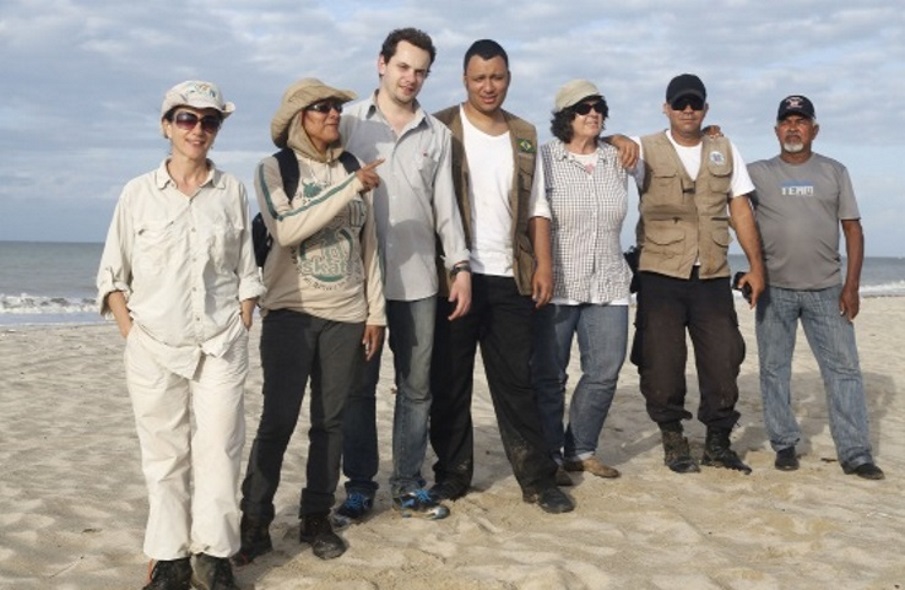





Ana Maria Góes, USP
Graduated in Geology at the São Paulo State University-USP (1976), M.Sc. at the Federal University of Pará-UFPA (1981), continuing education at the University of Campinas-UNICAMP (1985), and doctoral (1995) and postdoctoral (2006-2008) degree at USP. Retired professor from the Center for Geosciences of the UFPA. She is currently a collaborator professor at the Institute of Geoscience- USP, Institute of Geosciences at UNICAMP (UNICAMP) and Department of Geosciences of the Amazon Federal University-UFAM.
She has experience in Geosciences, with a main emphasis on sedimentology and stratigraphy, having acted on the following topics: facies analysis, sedimentary provenance with application in the oil industry, heavy minerals and sedimentary petrography. She has developed works focusing Paleozoic, Cretaceous and Cenozoic rocks of the Parnaíba and São Luís-Grajaú Basins in the States of Maranhão and Piauí, as well as Paraíba Basin in the State of Paraíba.
She holds a fellowship in research productivity from the CNPq (category 2). She has published 40 articles in national and international journals with editorial board and book chapters, and she has made 84 communications in scientific events. She has also contributed to publish 4 books.


Clodis de Oliveira Andrades Filho, Universidade Estadual do Rio Grande do Sul - UERGS
He is currently an assistant professor at the State University of Rio Grande do Sul (UERGS), where he has worked in the geology field linked to the Environmental Management, Agronomy, and Bioprocesses and Biotechnology Engineering.
He is a geographer, with master degree in Remote Sensing from INPE, doctor in Geosciences from USP. He specialized in morphotectonics, tectonics and sedimentation, and remote sensing applied to geology and geomorphology. In his research, he has integrated remote sensing data, passive and active gamma ray spectrometric and magnetic geophysical data, geospatial technologies and field geology/geomorphology. This researcher has particular interest in the tectonic and sedimentary evolution of the northeast coast of Brazil, particularly in the Paraíba Basin, while also acting on similar studies applied to the southern and northern Brazil.
He is a faculty member of graduate programs applied to Environmental Sciences. He is an associate member of the Association of Quaternary Studies (ABEQUA). He supervises 3 continuing education students. He also supervised 11 undergraduate students. He has published 13 articles in national and international scientific journals and one book chapter.


Dilce de Fátima Rossetti, INPE
Senior Researcher of the Remote Sensing Division (DSR) at the Center of Earth Observation (OBT) of the National Institute for Space Research (INPE), where he has worked since 2004. M.Sc. from the Federal University of Pará (1991) and PhD from the University of Colorado Boulder (1996).
She is geologist, specialized in sedimentology and stratigraphy. In her research, she has combined several techniques to acquire geological data in the field and laboratory, as well as geomorphological data derived from remote sensing images. With this strategy, she has contributed to approach key issues related to paleoenvironmental interpretations in a variety of geological terrains of the Brazilian territory, especially those with record of sedimentary deposits formed in the last 30 million years. Geographical areas of special interest in her research have been the northern and northeastern coasts of Brazil, as well as remote areas of the Brazilian Amazonia, where she has been working since 1987.
She was vice president of the International Association of Sedimentology (IAS) from 2010 to 2014, currently pursuing her contribution to this society as a council member representing the South America scientists.
She is a professor of the Graduate programs in Geochemistry and Geotectonics of the Institute of Geosciences at the São Paulo State University-USP and of the Remote Sensing Graduate Program at INPE, having supervised 11 M.Sc., 10 doctors and 16 scientific initiations at the undergraduation level.
She pursues a fellowship in scientific productivity granted by the CNPq (category 1B) and has published 133 articles in scientific journals and book chapters, 3 books, and 193 articles and papers in scientific meetings.


Fábio Correa Alves, INPE, bolsista mestrado CAPES
Supervisor: Dilce of Fatima Rossetti
Sub-project: MORPHOLOGICAL ANALYSIS AND MORPHOTECTONIC OF THE LOW PARAÍBA RIVER BASIN
Goal: His study has the objective to analyze the hypothesis of tectonic influence on the development of the Paraíba and Mamanguape river basins in the northern part of sedimentary Paraíba Basin based on morphostructural analysis supported by MDE-SRTM and multipolarized SAR image of the PALSAR sensor.
Master's student of the Graduate Program in Remote Sensing by the National Institute for Space Research (INPE). He was designated a geographer from the State University of Maringá (UEM) in 2013. Since 2010, he works with GIS and remote sensing data applied to geosciences. During his undergraduation, he worked with fluvial geomorphology, particularly focusing river systems of the Paraná drainage basin. He is currently developing a research project in the Paraíba Basin, Northeast Brazil, where he has investigated the influence of neotectonic activities not only as a control of drainage channels and relief morphology, but also in the genesis of neogene and Quaternary deposits. To reach these goals, he has explored field data and various digital image processing techniques applied to products of active sensors, including digital elevation model and synthetic aperture radar imaging.



Francisco Hilário Rego Bezerra , UFRN
Associate Professor, Department of Geology, Federal University of Rio Grande do Norte-UFRN.
He is a geologist and an expert on neotectonics, fault evolution, tectonic stress, stress field, intraplate seismicity, paleossismicity and morphotectonics. In his research, he has combined field geology data, dating and geophysical data, especially seismology, to describe the neotectonic evolution of the continental margin of Brazil. He has contributed to the understanding of the neotectonic evolution of the South America intraplate. Geographical areas of interest in his research include mainly the Northeast of Brazil, with works also in the Midwest and Southeast regions of Brazil and western Argentina.
He is a member of the graduate programs: (1) Geodynamics and Geophysics; and (2) Science and Petroleum Engineering (UFRN). He holds a fellowship from the CNPq (catergory 1C). He has published two books and over 60 articles in national and international journals with editorial board.
Jean Carlos Ferreira de Lima, UFRN, doutorado, CNPq
Supervisor: Francisco Hilary R. Bezerra
Sub-Project: GEOLOGICAL EVOLUTION AND MORPHOTECTONICS OF NEOGENE AND QUATERNARY DEPOSITS OF THE SOUTHERN PARAÍBA BASIN
Goal: This research project has the main objective of studying the development of geological and morphotectonic evolutionary processes that occurred in the south-central portion of the Paraíba Basin during the Neogene-Quaternary through the reconstitution of landforms, data georeferencing and geochronological analyses of sedimentary deposits.
He is a geographer, expert in geomorphology and a doctoral student at the Graduate Program in Geodynamics and Geophysics of the Federal University of Rio Grande do Norte-UFRN.
In his research, he has combined techniques for acquiring structural and sedimentological data in the field with geomorphological data derived from images obtained by remote sensing in order to detect neotectonic activities. Thereby, he has contributed to approach issues related to the interpretation of landforms in the eastern edge of the northeastern continental Brazilian margin, especially with regard to areas of sedimentary deposits formed in the last 30 million years in the Paraíba Basin.
He recently developed geological, structural and geomorphological research in western Argentina. He is a High School Professor in schools of the States of Pernambuco and Paraíba. He has started his research carrier having 3 publications in scientific journals.


Márcio de Morisson Valeriano, INPE
Technologist Senior of the Remote Sensing Division (DSR) of the Center of Earth Observation-OBT of the National Institute for Space Research-INPE, where he started working in 2003.
He is an agricultural engineer, specialized in remote sensing and Geographic Information Systems (GIS). In his current research, he has focused on the methodological development for mapping and analysis of topographic descriptors from Digital Elevation Models (DEM). In this line of research, he has contributed to the identification of specific features and the geomorphometric characterization of relief at scales of 1: 50.000 to 1: 250,000, based on processes developed in GIS environment.
He was the mentor and main creator of the Topodata - Geomorphometric database of Brazil, which provides topographic data drawn from the refinement and derivation of the DEM derived from the Shuttle Radar Topography Mission-SRTM, with a complete coverage of the Brazilian territory.
He is a professor of the Graduate Program in Remote Sensing at INPE, having supervised 8 M.Sc., 2 doctors and 7 undergraduate students. He has a fellowship in scientific productivity from the CNPq (catergory 2). He has published 48 articles in scientific journals, 2 book chapters, and made 84 papers communications in various scientific meetings.

Renata Guimarães Netto, UNISINOS
She graduated in Sciences, specialized in Biology from the University of the Sinos River Valley-UNISINOS (1984). M.Sc. (1988) and PhD (1994) in Geosciences from the Federal University of Rio Grande do Sul-URGS (1988).
She has been a professor at the UNISINOS since 1987, having acted for the second time as a coordinator of the Graduate Program in Geology since January 2014, in addition to be a professor specialized in paleontological studies.
She was editor-in-chief of the Editorial Board of scientific journal of the UNISINOS between 2004 and 2013 and of the Brazilian Journal of Paleontology from 2003 to 2011. She is currently associate editor of the periodic Paleontology Electronics.
She has acted in scientific research in ichnology since 1983, studying metazoan activities (especially of invertebrates) and, more recently, bacteria, along or within substrates and their applications in sedimentary geology with emphasis on paleoenvironmental and stratigraphic studies of high resolution. She has coordinated several projects in this research field, which resulted in 41 completed and 10 guidelines underway, including doctorates, masters and undergraduate research. She has 35 articles published in indexed journals, 14 chapters of national and international books, 3 national and international books published and 108 contributions in national and international events. She holds a fellowship of research productivity from the CNPq (level 2).


Rosana Gandini, USP, bolsista doutorado CAPES
Supervisors: Dilce de Fatima Rossetti and Renata Guimarães Netto
Goal : The aim of her doctoral project is to reconstruct sea level variation from neogene and quaternary strata of the Paraíba Basin, analyzing its link with eustatic and tectonic factors.
Doctoral student in Geosciences from the Geoscience Institute at USP. Biologist, expert in trace fossils applied to the reconstruction of sedimentary deposits. She develops her doctoral project focusing paleoenvironmental reconstruction of neogene and Quaternary deposits of the Paraíba Basin.
She has participated of research projects of the Group Ichnos-UNISINOS, with applications of ichnology in the Paraná Basin aiming: (i) studies of ichnology applied to the characterization of source and reservoir hydrocarbon rocks of Paleozoic units of the Paraná Basin in order to refine the interpretation of depositional facies and processes in transitional and shallow marine systemss; (ii) paleoenvironmental interpretation of permocarboniferous glacigenic deposits of the Itararé Group in areas of southern Brazil, combined with palynological studies; and (iii) paleoenvironmental interpretation of Triassic deposits of the Santa Maria Group, also southern Brazil.
She has experience in developing environmental studies to mediate conflicts between environmentalists and hydrocarbon exploration companies, having worked to mediate conflicts between Petrobras and environmentalists in the northern litoral of São Paulo.
She was a professor of technological courses such as Environmental Management and Oil and Gas at the Integrated College of São Sebastião and Caraguatatuba (SP).
She holds a scholarship from CAPES- PROEX at USP. She was a fellow of the Science without Frontiers Program from the CNPq. She published 4 articles in scientific journals and book chapters and 22 papers at scientific meetings.



Research Project 1: ETECS-Paraíba

Research Group
Landscapes in Time and Space (PATES)
Research Group
Landscapes in Time and Space (PATES)


Copyright 2015 © Instituto Nacional de Pesquisas Espaciais (INPE). Todos os direitos reservados

Sônia Hatsue Tatumi, USP
Doctor of Science from the University of São Paulo (1994). She is currently a research professor at the Federal University of Sao Paulo, Santos Campus, and accredited in the graduate programs of the Institute of Health and Society at UNIFESP and in the Department of Electrical Engineering, EPUSP. She holds the position of head of the Department of Marine Sciences, UNIFESP. She has also implemented the technique of optically stimulated luminescence (OSL) in Brazil, with numerous research in this field areas. Her main research is related to optically stimulated luminescence (OSL) and thermoluminescence (TL) crystals applied to geochronology and environmental dosimetry. Her other interests are: 1) improving the dating methodology (marine terraces, aeolian, colluvium, fluvial sediments and archaeological soil by luminescence of crystals; 2) implementation of the single grain dating method; 3) studies of point defects and their kinetics in luminescent emission; and 4) synthesis, morphological and luminescent characterization of crystalline nanostructured ceramic composites for dosimetry of ionizing radiation.












